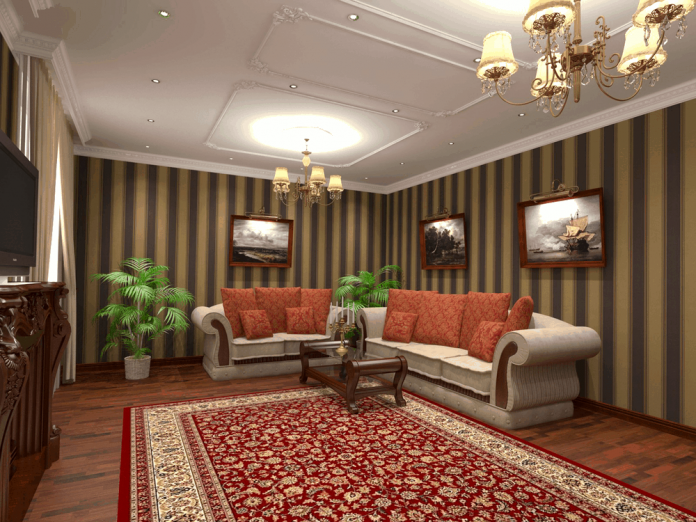Feel like the walls are closing in? If you have a small living room, rest assured, there are ways to make it appear bigger. When working with a space where every square foot counts, it’s beneficial to have intention when decorating. You may even have a bigger space than you think. Furniture placement, color, and light are just some of the ways a room can be manipulated to make it grow. Here we have a few design hacks to help give you some breathing room.
Trick the Eyes With a Rug

https://www.shutterstock.com/g/PinkyWinky
A living room rug can expand the space in a couple of ways. First, the right size will help. With area rugs, many people make the mistake of using a small size that rests between all of the furniture. This shrinks the space. Instead, opt for a large rug. When it sits under the main furniture pieces, the floor and room will appear bigger. Make sure to leave visible floorspace between the rug and the walls so that the room doesn’t look cramped. Also, consider a rug in a light color. This opens a room with an airy, light feeling, while a dark rug might make it feel smaller.
Use a Light Color Palette
Like the rug, using a light color in your decor is more reflective and gives the feeling of openness. (Dark colors absorb the light). Consider painting the walls white or using white furnishings. Don’t go overboard. An all-white room would be too sterile looking. Mix it up with a monochromatic color scheme using different white tones. Soft neutrals are also an option. Add depth by using sumptuous textures, or warm up the space with tan or leather furniture. If you’re working with colored walls, a white ceiling with a gloss finish will have a space-enhancing brightening effect.
Use Reflective Surfaces

https://www.shutterstock.com/g/JuanFranciscoGomez
Mirrors really are magical and a must for small rooms. They make a room look bigger because it gives the illusion that there’s more room (when really it’s just the reflection). Mirrors also reflect the light, which will help brighten up dark corners. Be strategic by positioning a mirror by the window for optimal natural light. A large framed mirror on the wall is the traditional choice, and acts as a beautiful decor piece. Other ways to sneak them in is through other furnishings, such as a mirrored chest, table, or cabinets.
Furniture Positioning
A common instinct is to place large furniture pieces against the walls, with the idea that you’re creating space in the center of the room. This isn’t always the best solution. Leaving space between the sofa and wall will look more open. A walkway is even better. Plus, a sofa that’s closer to the other seating furniture will make the living room seem more cozy and welcoming.
Streamline Clutter
Don’t use your coffee table as a mail dump. Clear your surfaces and streamline shelves. You don’t want a bookcase that’s completely stuffed. While packed bookcases looked cool in Beauty and the Beast, you’re probably not living in a castle. For a small living room, a couple gaps are easier on the eyes. If you think your small room can’t handle more storage pieces, think vertically. Floating shelves will hold objects without taking up floor space. Shelves that are positioned high on the walls will make the room look taller. A room always looks bigger when it’s neat and organized.
Rethink Window Treatments
Ditch heavy drapes that use heavy fabric or cover up valuable natural light. Dark, ornate fabric will swallow up space. Consider light and breezy sheer fabric that will still allow light to come through. Another trick is to use a longer rod than necessary, which will widen the walls. If you need more window coverage, blinds will give you natural light during the day, and then you can shutter them closed at night.
Shedding Light
A room enveloped in the shadows will look tiny. If you’ve adjusted your window treatments and the room still looks dark, add your own lighting. Besides lamps, recessed lights brighten a room tremendously, and don’t take up the space that a heavy light fixture might take up.
Sleeker Furniture
Furniture should be proportional to the space. The goal is to have more of the room be visible rather than blocking space with furniture. For example, furniture with legs will allow the eyes to view more floor space. The effect is an airier room and tricks the eyes into thinking there’s a bigger floor. A clear table will also fool the eyes. Don’t weigh down the room with heavy furniture. Oversized chairs and sofas will visually eat up space when you can accomplish the same function with something sleeker. Consider a contemporary decor style that utilizes clean lines, such as minimalist or mid-century modern.
Use the Ceiling
In a small living room, floorspace is valuable real estate. Utilize the ceiling. Instead of floor lamps, consider a hanging light. Plants are amazing pieces of decor and should still be used even in small rooms. Instead of a large potted plant, use a hanging planter for a dreamy natural accent.
Multitasking Furniture

https://www.shutterstock.com/g/lermont51
One piece of furniture is better than two when it comes to small living rooms. If you’re getting an ottoman, opt for a hollow one that doubles up as storage. There are convertible coffee tables that can also be used for storage or transformed into a desk. More examples are side tables containing pullout drawers and nesting tables that allow you to hold more items.
If you’ve been feeling claustrophobic, give one or more of these tricks a try. A couple adjustments will create the illusion of a bigger space. The result will be a comfortable living room for you and your guests.



![CREATING A COZY SHE SHED [INFOGRAPHIC] Home Renovation blog](https://www.homedecoratingtrends.com/wp-content/uploads/2019/03/interior-3433005_1280-1-218x150.jpg)